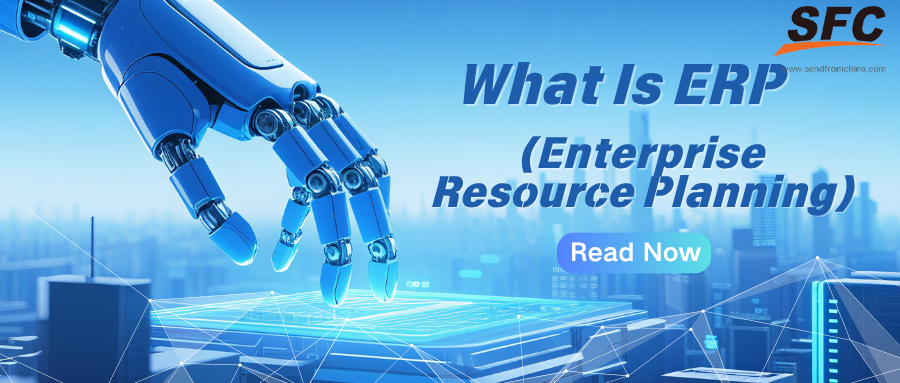Table of Contents
What Is ERP? A Comprehensive Guide to Enterprise Resource Planning
Time: Jul 07,2025 Author: SFC Source: www.sendfromchina.com
Enterprise Resource Planning (ERP) systems have become indispensable tools for modern businesses, streamlining operations and enhancing efficiency. This comprehensive guide delves into the fundamentals of ERP, its key features, benefits, deployment models, industry-specific applications, best practices for implementation, and addresses common questions.
1. What Is ERP(Enterprise Resource Planning)?
Enterprise Resource Planning is a suite of integrated software applications that organizations use to manage and automate core business processes. These processes include finance, human resources, supply chain, manufacturing, procurement, and more, all within a unified system.By consolidating data and processes into a single platform, ERP systems provide a "single source of truth," enhancing data accuracy and facilitating informed decision-making. Modern ERP solutions are available as on-premises, cloud-based, or hybrid models, catering to diverse organizational needs.
2. Key Features of ERP Systems
ERP systems encompass a wide range of functionalities designed to streamline business operations:- Financial Management: Handles accounting, budgeting, and financial reporting.
- Human Resources Management: Manages employee data, payroll, recruitment, and performance evaluations.
- Supply Chain Management: Oversees inventory, procurement, and logistics.
- Customer Relationship Management (CRM): Tracks customer interactions and sales data.
- Manufacturing and Production: Plans and monitors production schedules and quality control.
- Analytics and Reporting: Provides real-time insights through dashboards and reports.
These features enable organizations to operate more efficiently by automating tasks and providing comprehensive visibility into operations.
3. Pros and Cons of ERP
Enterprise Resource Planning systems offer a multitude of benefits that can transform business operations. However, they also come with challenges that organizations must consider. Understanding both sides is crucial for making informed decisions about ERP adoption.
Pros of ERP Systems
Enhanced Operational Efficiency
ERP systems streamline business processes by integrating various functions into a single platform. This integration reduces manual data entry, minimizes errors, and accelerates workflows, leading to increased productivity. For instance, automating inventory management can significantly reduce stock discrepancies and order processing times.Improved Data Accuracy and Decision-Making
With centralized data repositories, ERP systems ensure that all departments access consistent and up-to-date information. This real-time visibility enables better forecasting, budgeting, and strategic planning, as decision-makers can rely on accurate data to guide their actions.Scalability and Flexibility
Modern ERP solutions are designed to grow with your business. They can accommodate increased workloads, additional users, and new functionalities as needed. This scalability ensures that the ERP system remains a valuable asset as the organization evolves.Regulatory Compliance and Risk Management
ERP systems often include features that help businesses comply with industry regulations and standards. They provide audit trails, enforce data security protocols, and facilitate reporting requirements, thereby reducing the risk of non-compliance penalties.Enhanced Collaboration and Communication
By providing a unified platform, ERP systems break down departmental silos and foster collaboration. Employees can easily share information, coordinate tasks, and work towards common goals, improving overall organizational cohesion.Cost Savings Over Time
Although the initial investment in an ERP system can be substantial, the long-term cost savings are significant. Efficiency gains, reduced errors, and improved resource management contribute to lower operational costs and higher profitability.Cons of ERP Systems
High Implementation Costs
The upfront costs of purchasing and implementing an ERP system can be considerable. Expenses include software licenses, hardware upgrades, consulting fees, and training programs. For small to medium-sized enterprises, these costs can be a significant barrier.Complexity and Time-Consuming Deployment
Implementing an ERP system is a complex process that requires careful planning and execution. The deployment phase can take several months to years, depending on the organization's size and the system's complexity. Delays and disruptions during this period can impact daily operations.Resistance to Change
Employees may be resistant to adopting new systems, especially if they are accustomed to existing processes. Overcoming this resistance requires effective change management strategies, including clear communication, training, and support to ease the transition.Customization Challenges
While ERP systems offer a range of functionalities, customizing them to fit specific business needs can be challenging. Extensive customization may lead to increased costs, longer implementation times, and difficulties with future upgrades or system maintenance.Dependence on Vendor Support
Organizations become reliant on ERP vendors for system updates, technical support, and troubleshooting. If the vendor's support is inadequate or if the vendor discontinues the product, the organization may face operational risks and additional costs to transition to a new system.Potential for Operational Disruption
During the implementation phase, businesses may experience disruptions to their operations. Data migration issues, system downtimes, and learning curves can temporarily affect productivity and service delivery. Proper planning and contingency measures are essential to mitigate these risks.4. ERP Deployment Models: Choosing Your Architecture
Selecting the appropriate ERP deployment model is a pivotal decision that can significantly impact your organization's efficiency, scalability, and overall success. The three primary ERP deployment models—On-Premise, Cloud-Based, and Hybrid—each offer distinct advantages and considerations. Understanding these models in depth will empower you to make an informed choice that aligns with your business objectives.
On-Premise ERP
On-Premise ERP involves installing and running the ERP software on servers located within your organization's physical premises. This traditional model grants complete control over the system but requires substantial in-house IT infrastructure and resources.Advantages
- Full Control: Complete oversight of hardware, software, and data, allowing for tailored configurations and security protocols.- Customization: High degree of customization to meet specific business processes and requirements.
- Data Security: Enhanced data protection, as sensitive information remains within the organization's controlled environment.
Considerations
- High Initial Costs: Significant upfront investment in hardware, software licenses, and IT personnel.- Maintenance Responsibility: Ongoing responsibility for system updates, backups, and troubleshooting falls on the internal IT team.
- Scalability Challenges: Scaling the system may require additional hardware purchases and complex configurations.
Best Suited For
Organizations with robust IT infrastructure, stringent data security requirements, and a need for extensive system customization.Cloud-Based ERP
Cloud-Based ERP, also known as Software as a Service (SaaS), is hosted on the vendor's servers and accessed through the internet. This model offers flexibility and reduces the need for extensive in-house IT resources.Advantages
- Lower Upfront Costs: Subscription-based pricing eliminates the need for large initial investments in hardware and software.- Scalability: Easily adjust resources and functionalities to accommodate business growth or changes.
- Accessibility: Access the system from anywhere with an internet connection, facilitating remote work and real-time data sharing.
- Vendor Maintenance: The vendor handles system updates, maintenance, and security, reducing the burden on internal IT staff.
Considerations
- Data Security Concerns: Storing sensitive data off-site may raise security and compliance issues, depending on the industry.- Limited Customization: Customization options may be restricted compared to On-Premise solutions.
- Internet Dependency: System accessibility is contingent on a stable internet connection.
Best Suited For
Small to medium-sized businesses seeking cost-effective solutions with minimal IT infrastructure requirements and a need for flexibility.Hybrid ERP
Definition: Hybrid ERP combines elements of both On-Premise and Cloud-Based models, allowing organizations to maintain certain functions on-site while leveraging cloud services for others. This approach offers a balance between control and flexibility.Advantages
- Flexibility: Customize the deployment to retain critical operations on-premise while utilizing cloud capabilities for other functions.- Cost Efficiency: Optimize costs by allocating resources between on-site and cloud-based solutions as needed.
- Scalability: Easily scale specific components of the system without overhauling the entire infrastructure.
- Risk Mitigation: Distribute workloads to minimize the impact of potential system failures or security breaches.
Considerations
- Complex Integration: Ensuring seamless communication between on-premise and cloud components can be challenging.- Management Overhead: Requires careful coordination and management of both environments.
- Security Protocols: Implementing consistent security measures across both platforms is essential to protect data integrity.
Best Suited For
Organizations with specific compliance requirements, existing on-premise systems, and a desire to gradually transition to cloud solutions.5. Industry-Specific ERP Applications
ERP systems can be tailored to meet the unique needs of various industries:- Manufacturing: Focuses on production planning, inventory control, and quality management.
- Retail: Manages point-of-sale systems, inventory, and customer data.
- Healthcare: Handles patient records, billing, and compliance with health regulations.
- Construction: Oversees project management, budgeting, and resource allocation.
- Education: Manages student information, admissions, and academic records.
These specialized ERP solutions address industry-specific challenges and streamline operations.
6. Best Practices for Implementing ERP: Lessons from the Trenches
Successful ERP implementation requires careful planning and execution:
Assemble a Cross-Functional Project Team
A successful ERP implementation begins with a dedicated project team comprising members from various departments. This team should include:- Executive Sponsor: Provides leadership support and ensures alignment with organizational goals.
- Project Manager: Oversees the implementation process, manages timelines, and coordinates between teams.
- Subject Matter Experts (SMEs): Offer insights into specific departmental needs and processes.
- IT Specialists: Handle technical aspects, including system integration and data migration.
Having a diverse team ensures that the ERP system addresses the needs of all departments and facilitates organization-wide buy-in.
Define Clear Objectives and Key Performance Indicators (KPIs)
Before implementation, establish clear objectives and KPIs to measure success. Objectives might include reducing inventory costs, improving order fulfillment rates, or enhancing financial reporting accuracy. KPIs provide measurable benchmarks to assess the ERP system's effectiveness post-implementation.Conduct Thorough Business Process Analysis
Analyze existing business processes to identify inefficiencies and areas for improvement. This analysis helps in configuring the ERP system to optimize workflows rather than merely automating existing processes. Engaging stakeholders during this phase ensures that the system aligns with actual operational needs.Prioritize Data Migration and Integrity
Data migration is a critical component of ERP implementation. Ensure that data from legacy systems is accurately transferred to the new ERP system. This involves:- Data Cleaning: Remove duplicates and correct inaccuracies.
- Data Mapping: Align data fields between old and new systems.
- Testing: Validate data integrity post-migration.
Proper data management prevents future operational issues and supports informed decision-making.
Invest in Comprehensive Training Programs
User adoption is vital for ERP success. Develop training programs tailored to different user roles, ensuring that employees understand how to use the system effectively. Training should be ongoing, with resources available for new employees and updates as the system evolves.Implement Change Management Strategies
Change management addresses the human aspect of ERP implementation. Communicate the benefits of the new system, address employee concerns, and involve users in the implementation process. This approach fosters a positive attitude toward change and encourages user engagement.Choose the Right Implementation Partner
Selecting an experienced ERP implementation partner can significantly impact the project's success. Consider partners with:- Industry Experience: Familiarity with your sector's specific needs.
- Technical Expertise: Proficiency in the chosen ERP system.
- Support Services: Availability of ongoing support post-implementation.
A reliable partner provides guidance, mitigates risks, and ensures that the system is tailored to your organization's requirements.
Monitor and Evaluate Post-Implementation Performance
After the ERP system goes live, continuously monitor its performance against the established KPIs. Gather feedback from users to identify areas for improvement and make necessary adjustments. Regular evaluations ensure that the ERP system continues to meet organizational goals and adapts to changing business needs.7. Conclusion
ERP systems are powerful tools that integrate various business processes into a cohesive framework, enhancing efficiency and decision-making. While implementation can be complex and resource-intensive, the long-term benefits often outweigh the challenges. By understanding ERP's features, deployment options, and best practices, organizations can make informed decisions that align with their strategic objectives.8. FAQs
Q1: What does ERP stand for?
ERP stands for Enterprise Resource Planning, a system that integrates core business processes.Q2: Is ERP suitable for small businesses?
Yes, many ERP solutions are scalable and can be tailored to fit the needs of small businesses.Q3: How long does ERP implementation take?
Implementation timelines vary but typically range from several months to over a year, depending on complexity.Q4: Can ERP systems be customized?
Yes, ERP systems can often be customized to meet specific organizational requirements.Q5: What are the ongoing costs associated with ERP?
Ongoing costs may include licensing fees, maintenance, updates, and support services. Post Views:954
Post Views:954
Copyright statement: The copyright of this article belongs to the original author. Please indicate the source for reprinting.
Previous Post
Amazon FBA Packaging Requirements 2025: A Seller’s Guide to Compliance and Success
Next Post
Amazon FBA Labeling Requirements Explained: Tips for Accurate Product Labeling
TAGS
Hot Research
Get a Custom China Fulfillment Solution with FREE Storage for 30 Days
 Want to know about our services, fees or receive a custom quote?
Want to know about our services, fees or receive a custom quote?
 Please fill out the form on the right and we will get back to you within a business day.
Please fill out the form on the right and we will get back to you within a business day.
 The more information you provide, the better our initial response
will be.
The more information you provide, the better our initial response
will be.





 TAGS:
TAGS: